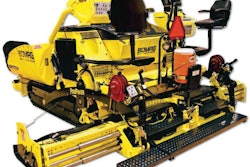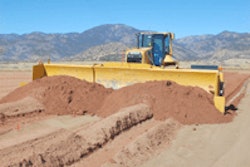Taking a breather
California contractors challenge off-road diesel regulations as CARB blinks.
By Mike Anderson

Do we have a taste of things to come here?
Like the well-intentioned conductor who stands before the orchestra, starts flailing his arms with devout certainty, and then stops and changes the tune, the California Air Resources Board (CARB) has left the state’s construction equipment owners and operators twisting and turning for much of the past decade. Contractors throughout the country, at times amused, at other times petrified, have ultimately been left likewise scratching their heads over what this all means.
But relief, perhaps may we even suggest clarity, could very well be on the California horizon. And what happens with CARB will, as usual, become a reference point for other states working with the same regulations.
In this instance CARB has suddenly, surprisingly, hesitated, appearing to back off its headlong charge to tighten off-road diesel regulations. Is it inevitable that other states will show a similar hesitation? One thing is clear – contractors will step into the void and strenuously press claims that regulations are doing immense, long-term damage to the profitability of the industry. That’s another trend we might see in states if CARB’s ‘let’s take another look at this” move leads to copycat delays.
In part a response to a petition made by the Associated General Contractors (AGC) of America on behalf of its California chapters, CARB has established a public-input timeline that will lead to its staff, by late summer or early fall, formally proposing “appropriate changes” to the state’s in-use off-road diesel-fueled fleet regulation.
“While I did not grant the AGC petition to adopt emergency amendments to the off-road regulation, we did issue an enforcement advisory indicating that emission-related requirements of the regulation would not be enforced until further notice,” CARB executive officer James N. Goldstene said at the opening of a follow-up hearing he chaired March 11 in Sacramento to take testimony and receive information from industry stakeholders. “Today’s hearing is somewhat unique in that, while it is not a hearing of our board, it is a formal hearing nonetheless and is being transcribed by court reporter.”
Following an overview of current regulations by CARB staff, AGC made a multi-speaker, hour-plus presentation of its case. Then came testimony from close to 50 industry advocates, watchdogs, regulators and, most prominently, contractors who shared their haunting personal stories of once-vibrant businesses left clinging to life by what they perceive as Draconian legislation made even more burdensome by historically horrific economic conditions. Information and testimony presented at the March 11 session, along with written submissions received in following days, are to be included in a CARB staff update to the governing board at its April 22 meeting. “That update is part of a comprehensive effort by staff to evaluate the effect of the recession on emissions and rule reductions for the truck and bus rule and the off-road regulation,” said Goldstene, CARB’s top administrator and theoretically the chief staff liaison to the board, “and in light of those findings determine what adjustments … should be proposed later this summer to provide relief.”
During her program overview to a three-quarters-full Byron Sher Auditorium at the headquarters of California’s Environmental Protection Agency (EPA), CARB off-road program manager Kim Heroy-Rogalski confirmed the current evaluation is taking into consideration one of the bones of contention formally raised by AGC. “We’re also evaluating some new information regarding the off-road inventory methodology that came to light earlier this year,” said Heroy-Rogalski, who laid out the timeline that will progress from CARB’s April board meeting , to public workshops in May and June, then to the board’s consideration of rule revisions in August or September. According to research sponsored by AGC, CARB back in 2000 overestimated by
40 percent the levels of nitrogen oxide (NOx) and particulate matter (PM) that would be put out by California off-road diesel engines in 2009.
Sticking to points raised in its emergency petition, emphasizing the recession’s double-edged effect of achieving overall desired emissions reductions while limiting companies’ ability to comply with fleet regulations, AGC regardless struck a decidedly conciliatory chord in its March 11 presentation. “The data will continue to drive AGC’s position on the off-road rule. In that context, we will continue to be transparent and we are committed to going wherever the data objectively leads us,” said Michael Kennedy, AGC chief counsel. “As I say that, I do remain confident that the board still has the cushion that it requires to extend the deadlines for compliance. It is simply wrong that the board has to choose between environmental protection and economic growth. This is one of those rare situations where you can, in fact, have it both ways.” Supported by testimony from Dr. Lynn Reaser, chief economist at Point Loma Nazarene University who cited the loss of 364,000 in-state construction jobs in the past four years, AGC proposes a two-year delay to California’s in-use off-road diesel-fueled fleet regulation.
The major source of strife for the state’s contractors, the regulation legislated in July, 2007 sources back to emissions data gathered in 2000. It established reporting requirements that took effect at various dates in 2009 for large (over 5,000 horsepower in total), medium (2,501 to 5,000 hp) and small (2,500 hp and less) fleets of off-road diesel equipment, primarily construction and mining machines. The reporting requirements, as fulfilled by contractors via the Diesel Off-road On-line Reporting System (DOORS), go beyond machine basics such as make, model, year and serial number to include details about Verified Diesel Emissions Control (VDEC) devices that must now be installed on the equipment. “Currently, over 150,000 off-road vehicles have been reported to us,” Heroy-Rogalski said at the March 11 hearing, “and there’s still more coming in every day actually.” The data gathered in 2000 set the stage for fleet average compliance requirements that were scheduled to take effect March, 2010 for large fleets, followed by requirements in March, 2013 for medium fleets, and in March, 2015 for small fleets.
But, after years of dire warnings from industry organizations and mere days before this past March’s compliance deadline for large fleets, CARB suddenly appeared to ease off.
[Reacting to] the loss of 364,000 in-state construction jobs in the past four years, AGC proposes a two-year delay to California’s in-use off-road diesel-fueled fleet regulation.
“Over the last several years, the construction industry has felt the sting of the faltering economy with reduced activity and idled off-road equipment. This has made it difficult for contractors to pay for required clean-air upgrades to their fleets. Along with this reduced construction activity has been a corresponding reduction in construction activity,” Goldstene announced Feb. 11. “Because of this, ahead of a March 1, 2010 compliance deadline, (C)ARB will issue an enforcement advisory to notify all stakeholders affected by the off-road equipment regulation that effective immediately, and until further notice, no enforcement action will be taken for non-compliance.”
It was, in the words of Southern California Contractors Association executive director Bill Davis, a “scammy little” press release. “The truth is that they don’t have enforcement authority under the Clean Air Act without a (federal) EPA waiver,” he said. “They also suspended enforcement of a portable (equipment) regulation that was going to take place this past year for the same reason.”
Heroy-Rogalski confirmed federal EPA authorization is required before CARB can enforce the performance requirements of the off-road regulation, including requirements to retrofit or turn over vehicles, as well as restrictions on adding lower-tier machines. Would-be penalties for failing to comply with the performance requirements are covered under various sections of the California Health and Safety Code, including fines up to $10,000 and $500 respectively per vehicle per day for PM and NOx violations.
During the March 11 hearing, the conciliatory tone of the AGC presentation was matched by Goldstene, CARB’s top staffer, who cordially welcomed speaker after speaker, patiently allowing them to share their stories, vent their frustrations and make their suggestions. With one exception, that being the second appearance by a company marketing a new catalytic product, no presenters were cut off. v












